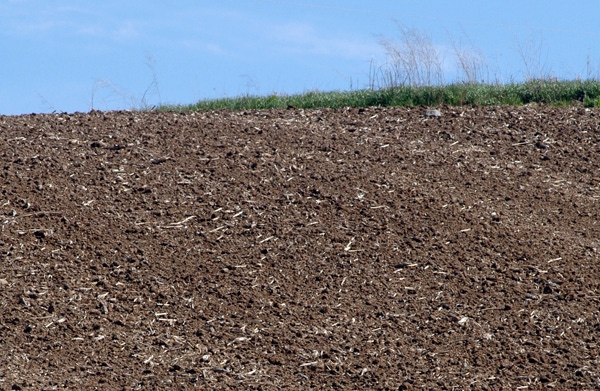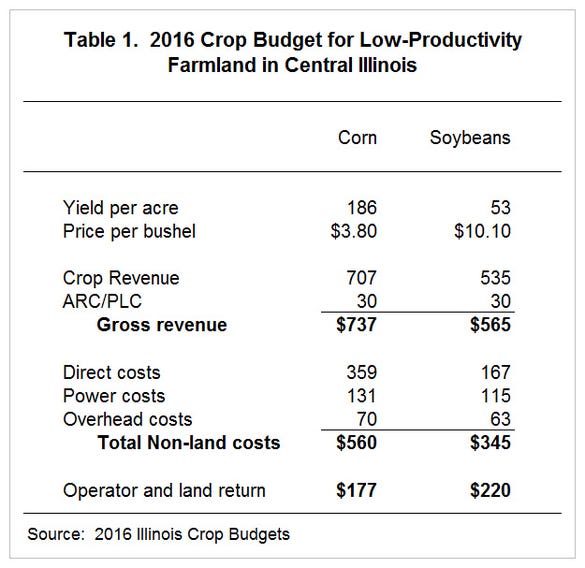
Current prices favor planting soybeans on remaining unplanted acres. Prevented planting will come into play if continued rain and wet soils prevent plantings until the final planting dates have been reached. The alternatives of planting soybeans or taking the prevented planting payment will be near one another, particularly when planting does not occur in mid to late June.
May 26, 2016

Weekly progress reports suggest some states are behind on both corn and soybean plantings. At this point, soybeans are projected to have higher returns than corn, suggesting that planting soybeans on remaining unplanted corn acres may be prudent from an economic standpoint.
Corn versus soybeans
Forward contract bids for 2016 fall delivery are near $3.80 per bushel for corn and $10.10 per bushel for soybeans. At these prices, soybeans are projected more profitable than corn in all regional budgets contained within the 2016 Illinois Crop Budgets, even without considering yield reductions associated with late planting of corn. Reducing corn yields in the budgets would further increase the returns advantage of soybeans over corn.
To illustrate, take yields and costs in the central Illinois budget for low-productivity farmland. Corn has a projected yield of 186 bushel per acre and soybeans of 53 bushels per acre. These yields are typical expected yields without factoring in late planting. At a $3.80 corn price, operator and land return is projected at $177 per acre for corn (See Table 1). The soybean return is projected to be $43 per acre higher at $220 per acre. Again, a lower corn yield results in a lower corn return, increasing the advantage of soybeans over corn.

Furthermore, hedging the soybean price on some or all of the planted soybean acres seems prudent. Current fall delivery prices are well above the $8.85 projected price used for setting crop insurance guarantees on soybeans. Downside price risk for soybeans also seems larger for soybeans than for corn (see farmdoc daily May 23, 2016).
Prevented planting on corn
Prevented planting payments are available from the COMBO crop insurance policy once the "final planting date" has been reached. The COMBO policy includes Revenue Protection (RP), Revenue Protection with the harvest price exclusion, and Yield Protection. Prevented planting payments do not exist for the Area Risk Protection Insurance policy.
Final planting dates for grain corn varies across Midwestern states. May 31 is the "final planting date" for Iowa, southern Minnesota and Wisconsin, northeastern Missouri, the extreme southern counties of Illinois, and Kentucky. June 5 is the date for most of Illinois, Indiana, Ohio, and Michigan.
Once the final planting date has been reached, a prevented planting payment for corn can be taken if corn is not planted for insurable causes (e.g., wet weather). Unless a 5 or a 10% buy-up has been purchased, the prevented planting payment will be 60% of the guarantee. Take a unit with a 170-bushel-per-acre guarantee yield, this year's projected price of $3.86 per bushel, and an 80% coverage level. In this case, the prevented planting payment will be $314 per acre (170 guarantee yield x $3.86 projected price x 80% coverage level x .60 prevented payment factor).
Several important notes about prevented planting payments are:
The crop insurance agent should be contacted before considering prevented planting. Prevented planting considerations can be complicated, with one concern being the number of acres eligible for prevented planting. Maximum eligible acres generally equals maximum acres of corn planting in the last four years, adjusted for acreage changes in the current year. A crop insurance agent can address this and other issues.
Prevented planting does not have to be taken over the entire insurable unit. However, there are minimum acres on which prevented planting can be taken. Minimums typically equal 20 acres or 20% of the acres in the insurable unit.
Taking prevented planting will not impact Actual Production History (APH) yields in future years.
More detail on prevented planting is given in a May 30, 2013 farmdoc daily article.
After the final planting date, a farmer has three options:
Take the prevented planting payment.
Plant corn. After the final planting date, the crop insurance guarantee will be reduced one percent per day for each day after the final planting date. This reduction will continue for 25 days. After 25 days, the insurance guarantee will be 60% of the original guarantee.
Plant soybeans.
The Prevented Planting Module will aid farmers in making the choices by calculating expected returns for the alternatives. The Prevented Planting Module is a part of the Planting Decision Model, a Microsoft Excel spreadsheet that is part of the FAST series available for download.
Most situations I have evaluated suggest that corn has a lower return than soybeans. Often, the projected returns of taking the prevented planting payment or planting soybeans are near one another, particularly if planting does not occur in mid to late June. Prevented planting payments increase for higher crop insurance coverage levels and the higher 65% and 70% prevented planting payment factors. As a result, prevented planting may have a higher expected returns for these 80% and higher coverage levels, particularly if the prevented planting factor has been bought up.
Current prices favor planting soybeans on remaining unplanted acres. Prevented planting will come into play if continued rain and wet soils prevent plantings until the final planting dates have been reached. The alternatives of planting soybeans or taking the prevented planting payment will be near one another, particularly when planting does not occur in mid to late June.
Originally posted by University of Illinois.
You May Also Like



